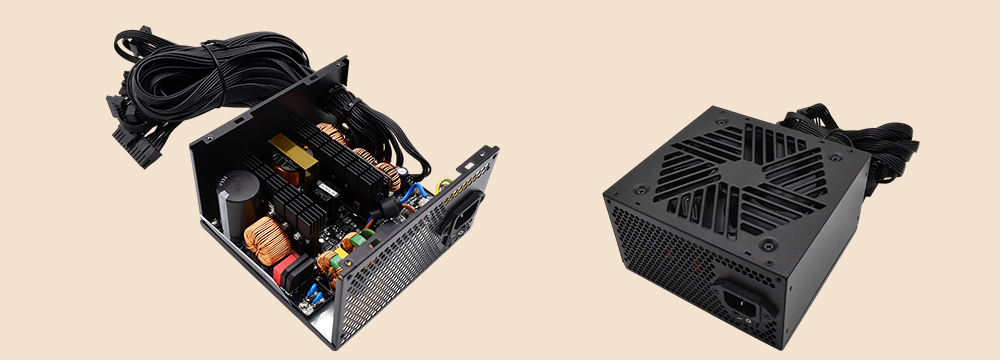We know that power supplies with low rated power can hardly meet the power supply needs of the system. At the least, the system will freeze frequently, and at the worst, it will not be able to start up or even damage the hardware. It is precisely because of this obvious consequence that consumers often only pay attention to the rated power of the power supply when purchasing power supplies, and ignore other aspects.
In fact, nowadays, when buying power supplies, it is no longer enough to focus on the rated power alone. We should also spend more time on the quietness and energy saving of the power supply. Maybe you have started to get confused when you see this. The rated power is expressed in numbers, which is clear at a glance, but how should we pay attention to other issues? Don't worry, the following methods can let you know more about the power supply in addition to the rated power.
Quiet--Look at the power supply fan
Generally speaking, the quiet effect of the power supply depends on the size of the fan used. You should pay attention to purchasing a power supply with a large diameter fan of 12cm or 14cm, because a large diameter fan can obtain the same large air volume at a lower speed, thus taking into account the needs of quietness and heat dissipation.
Output capacity--see the power supply standard
We know that Intel has put forward a series of design suggestions and reference specifications for computer power supplies, which is the ATX12V standard. It defines a series of contents such as the physical size, heat dissipation requirements, various connector configurations, electrical signal delays, etc. of the power supply. At present, this standard has been widely used as a non-mandatory power supply standard. In this case, we can simply judge the output capacity of the power supply through this standard.
The ATX12V specification is constantly changing with the development of technology. In the near future, it has been updated with 4 versions, namely the earlier ATX12V 1.3 and 2.0 versions, the current mainstream ATX12V 2.2 version, and ATX12V 2.3 version. We naturally will not consider the older versions, and which one is better to choose between 2.2 and 2.3 versions? Let's take a simple look at the differences between them.
The main difference between ATX12V 2.2 and 2.3 standards is the redistribution of power output. The ATX12V 2.3 standard was proposed considering the relatively low power consumption of the Core series processors and the increasing power supply requirements of the graphics card. Therefore, Intel reduced the power output of the +12V2 circuit for the processor power supply and increased the power output of the +12V1 circuit for the graphics card power supply in this standard. In addition, this version also improves the regulations on conversion efficiency and increases the requirements for energy saving on the basis of the ATX12V 2.2 standard.
Although it is generally believed that the new standard is always better than the old standard, it is not difficult to see from the above introduction that the power supply capacity of the processor is weakened in the 2.3 standard. Although the power consumption of the processor is getting lower and lower according to the current market situation, if the power supply you choose is for an earlier processor, then the power supply that meets the 2.3 standard is likely to have problems. In addition, since this standard has just been introduced, there are far fewer products that meet this standard on the market than those that meet the ATX12V 2.2 standard. Therefore, for now, it is more appropriate to choose a power supply that meets the ATX12V 2.2 standard.
Energy saving--see safety certification
Although in the above power supply standards, the conversion rate of ATX12V 2.3 version is higher than that of 2.2 version, and it is more energy-efficient in theory, but in fact, the actual energy-saving ability of the power supply depends on different manufacturers and the raw materials and technologies used. There are many standards for energy saving, such as "Technical Requirements for Certification of Energy-saving Products for Switching Power Supplies for Microcomputers" and "Energy Star". The former requires the minimum conversion efficiency of light load, typical load and full load to be 72%, 77% and 75%, respectively.
The latest standard of the latter, "Energy Star 4.0", is the same as the most demanding 80plus standard, which requires the conversion efficiency of the power supply to reach more than 80% under light load, typical load and full load. Purchasing a power supply that meets this standard can reduce unnecessary cost consumption. Although the price of such power supplies is relatively high, long-term use can save considerable electricity bills.
Summary
Of course, there are more things to look at on a power supply than what we have introduced, but as long as we grasp the main contradiction of the problem, other problems will be solved. Before purchasing a power supply, in addition to a detailed understanding of the power supply fan, power supply standards and safety certification mentioned above, you should also consider the corresponding product according to the actual configuration of your machine. For example, pay attention to whether the motherboard has an auxiliary power supply interface? Is it 4-pin or 8-pin?
Does the graphics card need an external power supply with a 6-pin interface? How many SATA power supply interfaces are required for the hard disk or optical drive? In short, when purchasing a power supply, you should have a clear idea of the configuration of the machine to be equipped, so that you can maximize the balance between quietness and energy saving.
IDEALPLUISNG Power Expert:
We focus on the research and development, sales and services in the fields of DC-DC power modules, AC-DC rectifier modules, DC-AC inverters, AC power supplies, DC power supplies, LED power supplies, chargers, rectifier systems, etc., providing personalized, efficient, reliable and cost-effective power solutions for all walks of life.
Thank you for considering our services.







